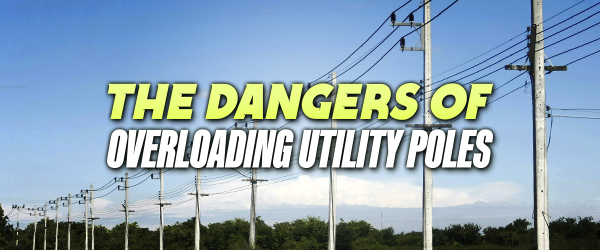
The Dangers of Overloading Utility Poles
Consumers generally take electricity and Internet connections for granted within the modern world and only notice if some unexpected problem occurs with their specific service. This means, that most people don’t exactly know how they get their electricity and Internet. Power companies and broadband providers, since they know people only care about their end product, prioritize giving customers excellent service.
Unfortunately, this sometimes means that safety and long-term planning can fall by the wayside, and this can have dangerous consequences. It is common for utility poles to be overloaded through routing more current and energy than they are meant to handle. Many of these poles are also not as well maintained as they should be due to relying on outdated technology or just becoming broken. This can lead to small problems like power outages or more significant problems, such as wildfires.
Some telecommunications companies have encountered trouble in the past because of potential utility pole overloading. The state of California’s Public Utilities Commission investigated utility companies in the early 2000’s in connection with wildfires in that state. Although the regulations on utility poles vary by state, they are generally strict, specifically imposing limits on how much equipment a utility pole can safely support. Violating these regulations can cause not only safety hazards but significant legal headaches for companies, most notably if more than one company owns an individual utility pole.
A wildfire in 2007 started when three electric utility poles snapped because they exceeded weight restrictions. When utility poles are present for a long time, it’s easy to miscalculate weight and current load on them without adherence to strict regulations, and keeping them up to date is crucial for safety. Some utility poles are significantly older than they appear, and some that were initially installed in the 1950’s are still in use today. These older poles, when maintained properly, in most cases, can work as well as newer construction. Without maintenance, like monitoring wind shear or weight loads, however, these older poles can fail and cause significant safety hazards.
Damage from fires or power problems caused by broken utility poles can be costly for a company, and many inconvenienced consumers do not wait long to file lawsuits. It can also be costly to upgrade utility poles or to reconfigure their loads, however; so it isn’t uncommon for complaints to go unaddressed for extended periods of time. Re-balancing an overloaded utility pole isn’t always a simple endeavor, because it needs to be done with as little interruption to consumers as possible while still correcting the problem. Sometimes, a new utility pole can be erected to share loads, but sometimes that isn’t possible and more costly solutions are necessary. Safety, time, money, and effort are all considerations.
Utility poles can hold many different types of materials, from electric lines to fiber optic cables and cellular radios and antennae. All of these things draw power and have weight, increasing the amount of stress on a utility pole in multiple ways. The number of connections needed as the world becomes more dependent on technology is going to exponentially increase. Utility poles, as they are known today, may one day not be able to fulfill the demands that can become required of them. As more components are installed upon utility poles, the risk of wildfires, power outages, and pole failures increases, but consumers aren’t aware of what their demand for power can require.
The solution that cities have frequently come up with, so far, is to move wires underground, but this is a labor-intensive and costly process. In some jurisdictions, this can cost one million dollars for every mile of wire. In big cities, this cost is prohibitively high, and despite the risks involved, budget planners often allocate funds to other, more urgent matters. This means that overloaded utility poles are often left as they are, with no significant improvement, until something goes wrong.
The Smart Vault, by SYNDÉO, offers a new solution to this persistent problem. Since one of the best solutions to overloaded power poles is to place additional equipment, such as small cells, underground. Smart Vaults enable cities to do this at a cost that is competitive to replacing or adding poles to accommodate additional equipment. A Smart Vault is secure, waterproof, environmentally controlled, and can be strategically concealed under ADA curb ramps, sidewalks and terraces. With digital security, sensors, data analytics, and geothermal or thermoelectric cooling systems, the Smart Vault is safer than traditional utility poles, can be monitored more efficiently, and can handle higher loads. Instead of relying on outdated and overloaded poles to accommodate the placement of small cells and other smart city technology, Smart Vaults use advanced enclosure technology to provide cities with safe and secure space that is subsurface along streets. Doing so, reduces the risk of fires and accidents and empowers cities to become, “Smart City Technology Ready.”

